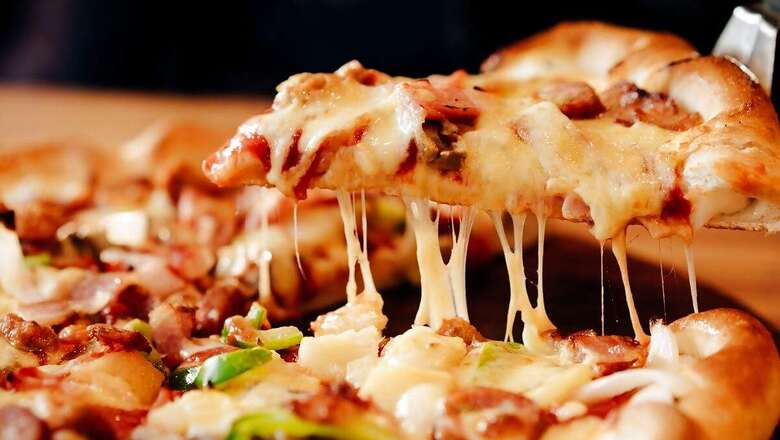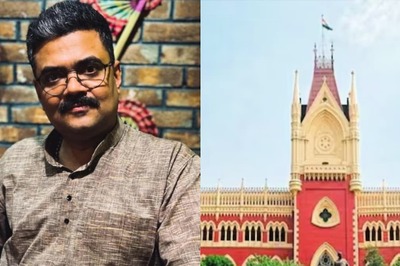
views
If I remember right, I first heard of pizza and tasted one, somewhere around the late 70s and the early 1980s. That is long before the big American chains entered the Indian market. Don’t get me wrong, I wasn’t one of those lucky kids, whose parents endowed them with foreign vacations and hence were lucky enough to taste a slice of New York Pizza on the streets of Manhattan or a Naples style Margherita in Italy.
I tasted my first pizza, right here in Mumbai, first at Sukh Sagar at Chowpatty and then later on at Haji Ali Juice Centre. It was the classic Indian Street Style Pizza, that even today, more than half of Mumbai still eats. When this roadside snack bar and juice centre opened in the 1960s, Haji Ali Juice centre, stood at a busy circular junction. The twinkling lights of the majestic Haji Ali Dargah in the shimmering night sea was the backdrop. And a tall, nearly five-storey-high water fountain spouting jets of water lit up by coloured lights in front of it.
The menu was quite simple and vegetarian catering to the visitors of Mahalaxmi temple and the Dargah. It was sandwiches, toasted sandwiches, grilled sandwiches, juice and milkshakes. And then there was the pizza – an Indian one.
Now we all know that the pizza originated in Italy specifically in Naples. But the history of pizza is a story of adaptation, creativity, and the exchange between cultures. From ancient flatbreads to the modern, pies, the pizza’s journey is all about its enduring appeal and its ability to bring people together over food.
The pizza has had age-old beginnings. First, as a thin layer of dough topped with cheese and honey called “placenta”, and then to flatbreads with various toppings, including olive oil and local spices that the Greeks, Egyptians, and the Romans enjoyed. In the Middle Ages, these flatbreads became popular across the Mediterranean.
In Naples, during the Middle Ages, a dish known as “schiacciata” emerged. It was a simple flatbread topped with olive oil and local seasonings. This was long before the tomato revolution. The introduction of tomatoes to Europe from the Americas in the 16th century marked a transformative step towards creating the modern pizza, with the addition of tomatoes to flatbreads in Naples. Later, in the late 19th century, Italy’s Queen Margherita visited Naples, and a local pizzaiolo named Raffaele Esposito created a pizza to honour her. He combined tomatoes, mozzarella cheese, and fresh basil leaves to create a patriotic masterpiece that showcased the colours of the Italian flag. This was the Margherita pizza.
In the late 19th and early 20th centuries, a wave of Italian immigrants moved to various parts of the world including the United States. They took their culinary traditions with them, amongst them the pizza. The first pizzeria in the United States, Lombardi’s, opened in New York City in 1905. Today, the New York Style Pizza is an iconic American pizza known for its large, foldable slices with a crust that is thin and slightly crisp along the edges, and soft and pliable in the centre. It is smeared with a thin layer of tomato sauce made from crushed tomatoes and seasoned with herbs and spices, and topped with low-moisture, dry mozzarella cheese that melts and bubbles during baking. Of course, you can get a variety of toppings like pepperoni, Italian sausage, mushrooms, green bell peppers, onions, and black olives.
Back home in India, it was not until the 1990s that Indian chains like Don Giovanni’s, Nirula’s and Vijay Mallya owned Pizza Express began serving American style pizza to the masses. Then, finally, in 1995, foreign chains such as Dominos and Pizza Hut started entering the Indian market, but it was not before they tweaked their recipes and bowed down to the Indian palate that they really made a mark. The Pizza Hut at Mumbai Chowpatty was forced to turn a 100% vegetarian. The first international pizza chain in the world with a pure vegetarian and Jain menu.
New Yorker at Chowpatty (I don’t know why Chowpatty in Mumbai seems to be the birthplace of Mumbai’s pizzas) started doing pure Indianised vegetarian pizzas along with Indianised Italian, Indianised Continental and Indianised Nachos, Enchiladas, Tortillas, Fajitas and Burritos.
Today, Mumbai’s pizza has found its oeuvre. It started with Trattoria at the Taj President, where they made, what we then called, real Italian pizza. Topped with pepperoni, salami, even ham and pineapple. Today, there are many more like Gustoso, which makes a mean parma ham, parmesan and rocket pizza, or Bandra’s go-to neighbourhood pizzeria Ray’s Café and Pizzeria. I love their Quattro Formaggi with blue cheese, ricotta, mozzarella and parmigiana and their three-meat pizza with ham, bacon and sausage.
The fancy Kala Ghoda American Café Americano makes a super light and crispy pizza called The Rosso, with great dough, topped with tomato, oregano, garlic and olive oil. Of course, CinCin at Bandra Kurla Complex, who do the most cheerful Italian food, also do some refreshing pizza. I just love their Funghi e Tartufo, crispy wood-fired pizza with portobello mushrooms, porcini cream and fresh black truffle shavings and the Diavola Pizza, with a topping of chicken, spicy and smoky calabrian chillies and grilled onions.
Though all these fabulous pizzas are now available in Mumbai, even today, after a long day at work, if I am driving past Peddar Road towards the Race Course, heading to Worli, I often stop my car at the curb side Haji Ali Juice Centre. At any given hour, a server with an aluminium tray will appear out of the darkness, to take your order. And my order is always a ‘veg cheese pizza’. It is much smaller, approximately an 8 inch, a pre-baked circular bread, smeared with a hearty muscular tomato sauce, made with tomatoes, onion, ginger, garlic, red chili flakes, ketchup and chili powder. The base is then topped with capsicum, raw slices of onion, coriander, and an excessively generous amount of processed cheese. The pizza comes out crisp from the bottom as well as the top. The processed cheese like an au gratin, golden brown. Yes, I still like my pizza margherita — thin crust, crushed San Marzano tomato, fresh mozzarella, basil with a drizzle of fine olive oil, but for me, the Haji Ali one, is the most delicious Indian pizza you can try on this side of the Arabian Sea.
Kunal Vijayakar is a food writer based in Mumbai. He tweets @kunalvijayakar and can be followed on Instagram @kunalvijayakar. His YouTube channel is called Khaane Mein Kya Hai. The views expressed in this article are those of the author and do not represent the stand of this publication.



















Comments
0 comment